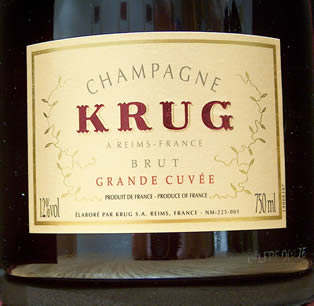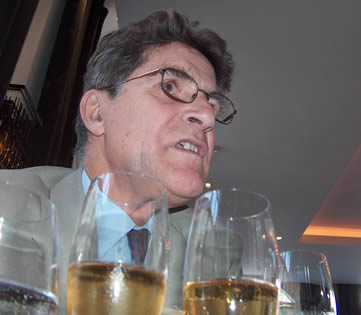|
Krug: iconic fizz
 I’ve
a confession to make. Until fairly recently, I wasn’t really
‘into’ Champagne. How crazy is that? My prejudice was that this
was a wine whose reputation had been enhanced by a sense of occasion
and some fairly serious protectionism by the Champenois, and that it
didn’t offer the same level of geeky appreciation as other wine
styles. Let’s be brutally honest: adding fizz was a clever way of
making an otherwise rather inadequate base wine from northerly
vineyards taste good. I’ve
a confession to make. Until fairly recently, I wasn’t really
‘into’ Champagne. How crazy is that? My prejudice was that this
was a wine whose reputation had been enhanced by a sense of occasion
and some fairly serious protectionism by the Champenois, and that it
didn’t offer the same level of geeky appreciation as other wine
styles. Let’s be brutally honest: adding fizz was a clever way of
making an otherwise rather inadequate base wine from northerly
vineyards taste good.
I’ve now changed my mind, you’ll be glad to hear.
Champagne is worthy of
serious investigation, but you knew that already, didn’t you? It
takes the art of fine discrimination of flavours and aromas another
step forwards. Having said this, it’s not cheap. Basic, entry level
Champagnes start north of £10 a bottle, and things only start getting
really interesting when you’ve dug a lot deeper than this.
What first changed my mind? Krug. Back in September
2004 I was at a wine dinner with some chums in Singapore and someone
brought along the Krug Grande Cuvée. It was fantastic, with depth,
balance, precision and lots of class. Yes, these words are hard to
define, but when you come to describe fizz, straight descriptors prove
woefully inadequate and instead of reductionist looking-for-flavours-and-aromas
you have to start using these more holistic, ethereal adjectives.
 A
year later, September 2005, I got to have lunch with Rémi Krug
himself (right) at wonderful London restaurant The Ledbury. As
well as the Grande Cuvée, I tasted three Champagnes that will live
with me for a long time: the 1988, 1989 and 1990 vintages. A
year later, September 2005, I got to have lunch with Rémi Krug
himself (right) at wonderful London restaurant The Ledbury. As
well as the Grande Cuvée, I tasted three Champagnes that will live
with me for a long time: the 1988, 1989 and 1990 vintages.
The UK is the third biggest market for Krug taking a
fifth of production. Volumes have increased over recent years. A
couple of years ago about half of production went to the airlines, but
with the economic squeeze on carriers in recent years, first class
fliers have had to make do with less stellar wines, so no more Krug.
But this loss of business has freed up volumes for other markets, and
airlines weren’t all that profitable anyway. Krug’s total
production is secret, but Rémi disclosed that it is 0.05% of
Champagne’s total, perhaps around half a million cases annually.
Is there a problem getting good quality grapes, given
Krug’s desire to gradually step up production of Grande Cuvée each
year? ‘Growers know that Champagne is driven by top-end brands’,
say Rémi. ‘They are eager to supply us; we are not in conflict with
them’.
Rémi points out that overall, Champagne production is
limited geographically to some 300 million bottles each vintage.
‘The issue is how the system favours those people who have an
individualistic attitude’, he explains. ‘There is still space
within Champagne for evolutions within that space, to reduce generic
offers and produce more Clicquot, Krug, Bollinger and so on.’ He
suggests that the way forward for the region is to shift more to the
brands rather than making generic Champagnes.
Krug Grande Cuvée is taken very seriously; it’s not
considered secondary to the vintage wines. ‘Most Champagne houses
create the blend by hierarchy’, says Rémi. ‘We don’t do it that
way: it is Krug or out! What doesn’t please us disappears. Grande
Cuvée is always our first decision. If there is a conflict, Grande
Cuvée wins. If we favoured the Vintage, Grande Cuvée would turn out
to be skinny.’ It has one-third to one-half reserve wines from 1990
to 2004.
Don’t try to ask too many questions about the precise
details of these wines, though. ‘I don’t like to reduce my wines
to technicalities’, says Rémi. ‘These should be backstage. If you
promote a movie or a novel, you don’t talk about the technicalities,
but the emotions.’
‘Grape percentage is a dead story to me’, he
continues. ‘It is not a recipe issue. I am not interested in cepage
except for in terms of terroir. The back label tyranny turns wine into
a recipe, and it started in California. Using the analogy of a
symphony, knowing the percentage of violins provides you with a false
understanding.’
What does Rémi like to drink at home (apart from fizz,
of course)? He loves Bordeaux, and particularly admires St Julien for
its finesse, delicacy and subtlety allied with character. He also has
wines from the likes of Spain, Italy, New Zealand and Australia in his
cellar. Is he just trying to sound catholic in his tastes here? It’s
hard to tell. Normally, at home, wines are decanted and served blind.
Can I come to dinner? Sounds fun.
 
Storage conditions are critical for Champagne.
‘People talk a lot about disgorgement, but this isn’t a story for
the public, even though people make a big issue out of it’, says
Remi. ‘With old Champagne, you need to consider the age and the
brand – some are made to age well, with Krug as the extreme example.
Then you need to look how it has been stored.’ He maintains that the
barrel ageing employed by Krug gives their wines an exceptional
lifespan. ‘For Krug time, multiply the time for other Champagnes by
ten.’
The wines
I’m rating these on how they showed when tasted. With time,
I’d expect the 88 and 90 to rate even better, whereas the 89 is
peaking now. Rémi describes the 1988 as fresh, crisp, lively,
energetic and exuberant, and the 1989 as rich, intense and mellow. The
1990, he thinks is a different dimension. ‘Think of the 1990 as
taking the best of the two and transcending to another peak, combining
the warmth and ripeness of the 1989 with the crisp dynamics of the
1988.’
Krug Grande Cuvée
Lovely fresh full herbal nose is very expressive with a subtle
hint of greenness and some complex toasty notes. The palate has great
concentration. It’s fresh and bright with high acid and a slightly
herby edge. Complex and full with an acidic finish. A serious
Champagne, but really needs a bit of time to show itself at its best.
Very good/excellent 92/100
Krug Vintage 1988
Quite a deep colour. A beautiful, deep intense nose with subtle
nutty and toasty notes. The powerful, intense savoury palate has
wonderful freshness and bold complexity. Quite tight and lean: savoury,
complex and full. Fantastic stuff with a long life ahead of it.
Excellent 95/100
Krug Vintage 1989
Incredible rich open nose showing honeyed, toasty, rich fruit with
some peach and apricot notes. It’s quite profound. The palate is
rich, showing some evolution. It’s bold and hauntingly complex.
Fantastically rich and opulent with a nice richness of texture.
Excellent 98/100
Krug Vintage 1990
Very refined complex nose: tight, rich, toasty, slightly honeyed
ripe apricotty notes here. It’s beguiling, complex and full. The
palate is crisp, tight and fresh with bright acidity. Complex and bold
with lots of weight, but intensely fresh and bright with good acidity.
A very serious wine with a bright future ahead of it. Brilliant.
Excellent 97/100
wines
tasted 09/05
see
also: a more recent tasting of Krug's
wines
Back to top
|

